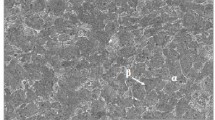Conclusions
-
1.
The main reason for the tendency of weld joints in titanium alloys toward delayed cracking is the creased hydrogen content.
-
2.
High-strength titanium alloys as well as titanium alloys of medium and low strength with an increased amount of nitrogen and oxygen are more likely to form cracks because of lower ductility, all other things being equal.
-
3.
The most dangerous point for the occurrence of delayed cracking in welded compounds of titanium alloys is the heat-affect zone.
-
4.
The suggested method of carrying out prolonged bending tests on titanium alloys makes it possible to determine their tendency toward delayed cracking.
Similar content being viewed by others
References
G. A. Lenning, C. M. Craighead, R. I. Jaffe, Journal of Metals, No. 3, 1953.
L. S. Moroz and others. Study of Mechanism of Hydrogen Embrittlement of Titanium and its Alloys. Metallography, Coll. Articles, Sudpromgiz, 1959.
N. I. Blok and others. Izvestiya AN SSSR, OTN, No. 12, 1958.




